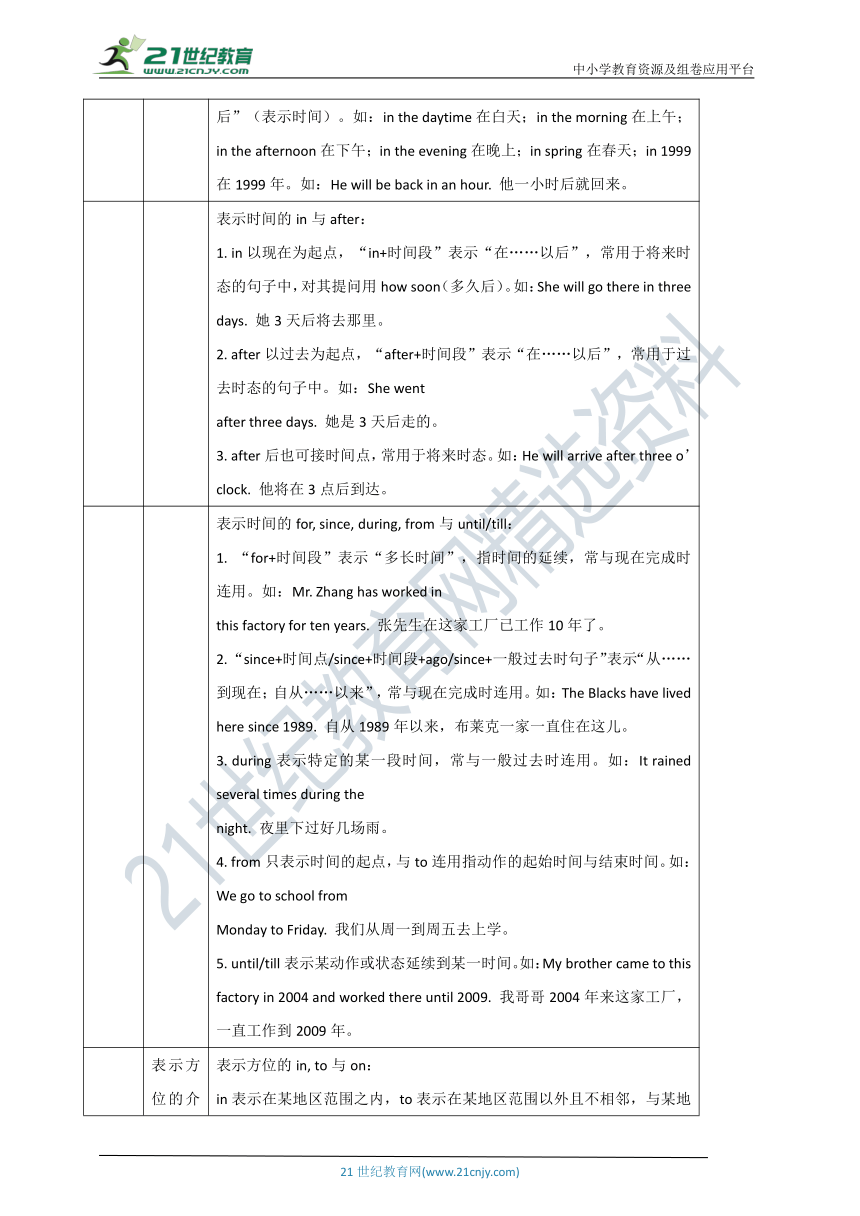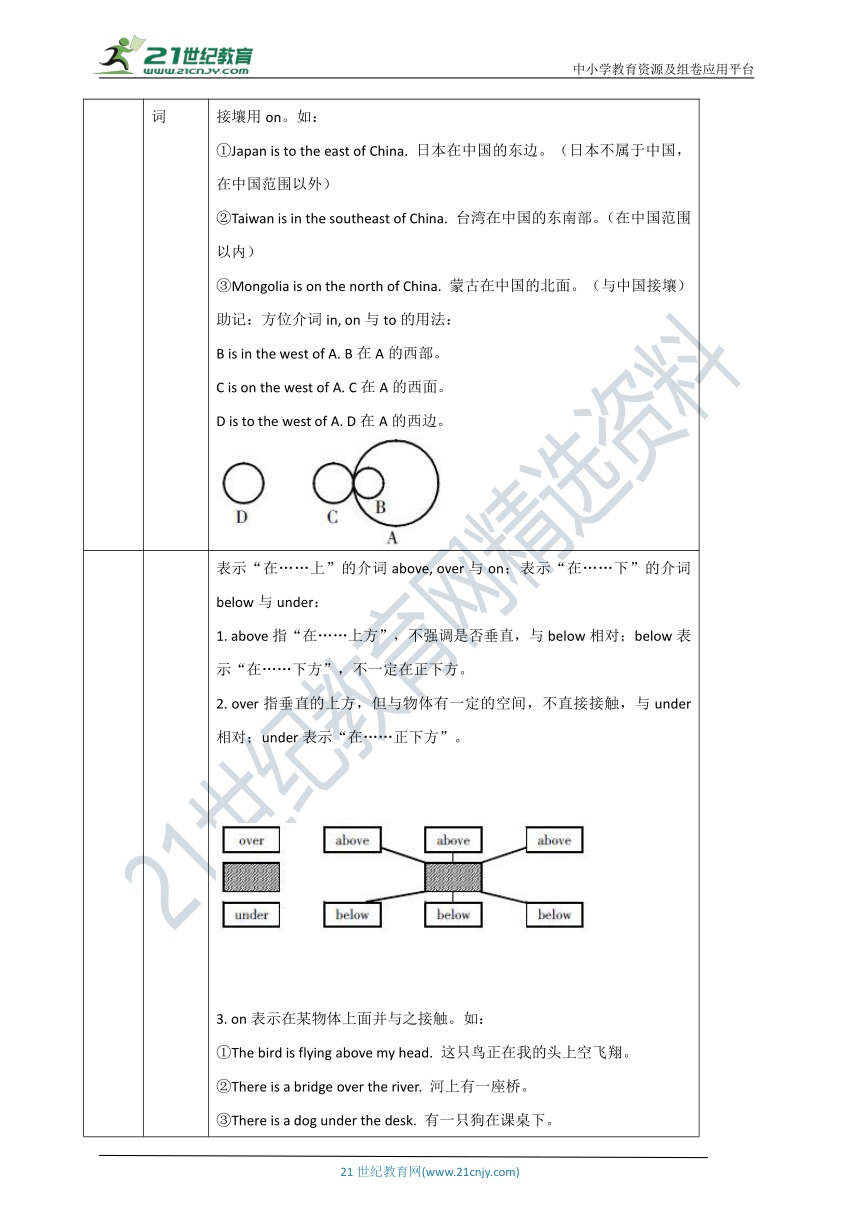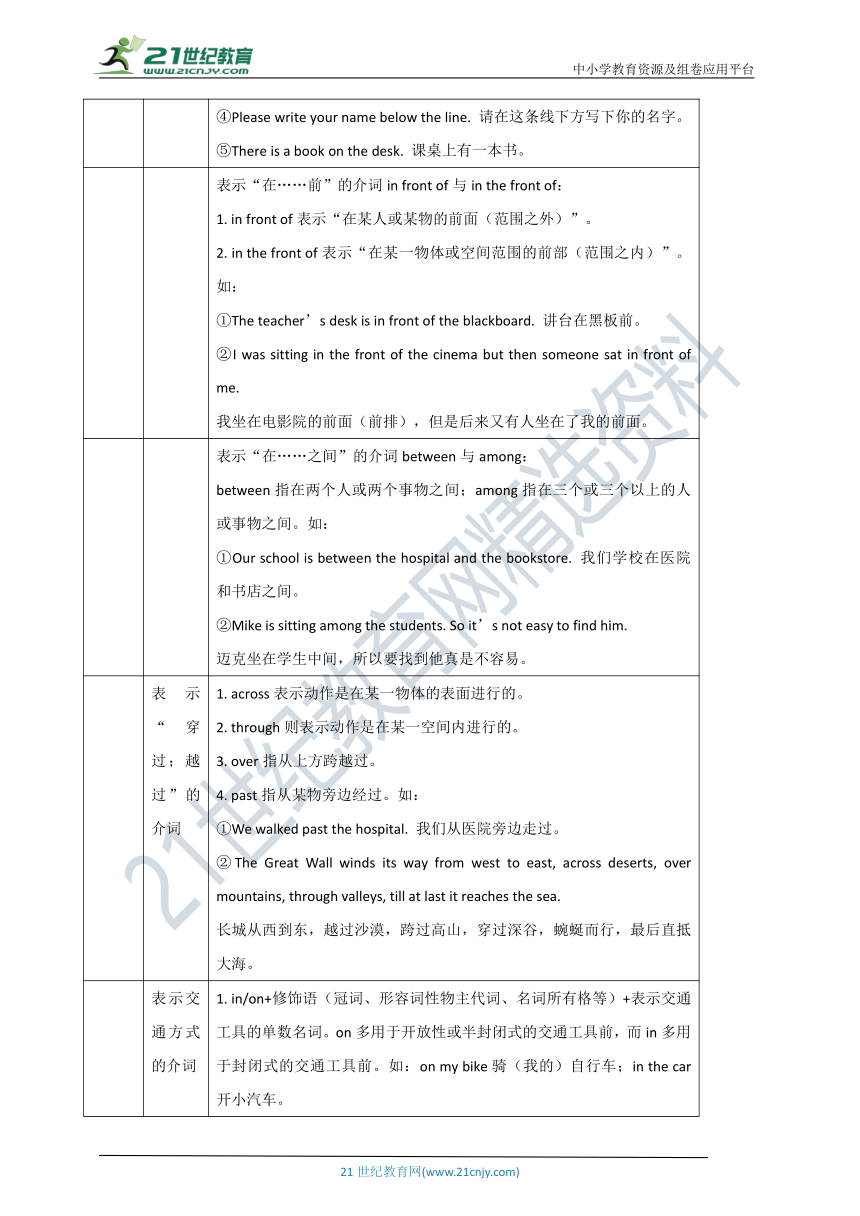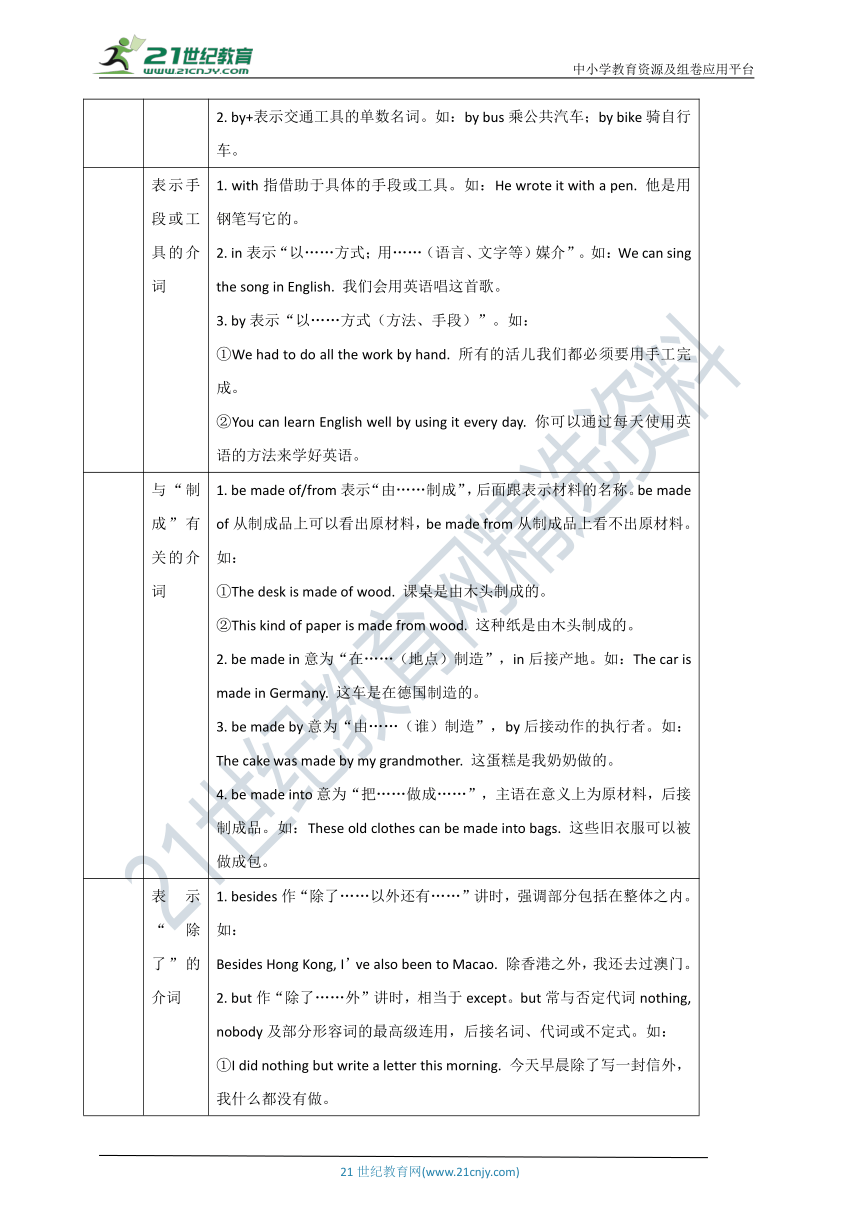外研版英语中考语法专项——介词与数词 知识梳理+实战演练(含答案)
文档属性
| 名称 | 外研版英语中考语法专项——介词与数词 知识梳理+实战演练(含答案) |  | |
| 格式 | doc | ||
| 文件大小 | 1.6MB | ||
| 资源类型 | 试卷 | ||
| 版本资源 | 外研版 | ||
| 科目 | 英语 | ||
| 更新时间 | 2022-02-08 20:55:17 | ||
图片预览





文档简介
中小学教育资源及组卷应用平台
外研版英语中考语法专项
介词与数词
介 词
常见考点记忆导图
语法精讲
常用介词的主要用法 表示时间的介词 表示时间的at, on与in:1. at主要表示在某时刻或中午、半夜、黎明等。如:at six o’clock在6点钟;at noon在中午。2. on主要表示在某一天、周几,也可表示在具体某一天的上午、下午、晚上或某一特定的日子。如:on New Year’s Day在元旦;on a cold evening在一个寒冷的晚上;on Monday morning在星期一的早上。3. in主要表示月、季节、年、世纪;泛指上午、下午、晚上;还表示“……后”(表示时间)。如:in the daytime在白天;in the morning在上午;in the afternoon在下午;in the evening在晚上;in spring在春天;in 1999在1999年。如:He will be back in an hour. 他一小时后就回来。
表示时间的in与after:1. in以现在为起点,“in+时间段”表示“在……以后”,常用于将来时态的句子中,对其提问用how soon(多久后)。如:She will go there in three days. 她3天后将去那里。2. after以过去为起点,“after+时间段”表示“在……以后”,常用于过去时态的句子中。如:She wentafter three days. 她是3天后走的。3. after后也可接时间点,常用于将来时态。如:He will arrive after three o’clock. 他将在3点后到达。
表示时间的for, since, during, from与until/till:1. “for+时间段”表示“多长时间”,指时间的延续,常与现在完成时连用。如:Mr. Zhang has worked inthis factory for ten years. 张先生在这家工厂已工作10年了。2. “since+时间点/since+时间段+ago/since+一般过去时句子”表示“从……到现在;自从……以来”,常与现在完成时连用。如:The Blacks have lived here since 1989. 自从1989年以来,布莱克一家一直住在这儿。3. during表示特定的某一段时间,常与一般过去时连用。如:It rained several times during thenight. 夜里下过好几场雨。4. from只表示时间的起点,与to连用指动作的起始时间与结束时间。如:We go to school fromMonday to Friday. 我们从周一到周五去上学。5. until/till表示某动作或状态延续到某一时间。如:My brother came to this factory in 2004 and worked there until 2009. 我哥哥2004年来这家工厂,一直工作到2009年。
表示方位的介词 表示方位的in, to与on:in表示在某地区范围之内,to表示在某地区范围以外且不相邻,与某地接壤用on。如:①Japan is to the east of China. 日本在中国的东边。(日本不属于中国,在中国范围以外)②Taiwan is in the southeast of China. 台湾在中国的东南部。(在中国范围以内)③Mongolia is on the north of China. 蒙古在中国的北面。(与中国接壤)助记:方位介词in, on与to的用法:B is in the west of A. B在A的西部。C is on the west of A. C在A的西面。D is to the west of A. D在A的西边。
表示“在……上”的介词above, over与on;表示“在……下”的介词below与under:1. above指“在……上方”,不强调是否垂直,与below相对;below表示“在……下方”,不一定在正下方。2. over指垂直的上方,但与物体有一定的空间,不直接接触,与under相对;under表示“在……正下方”。3. on表示在某物体上面并与之接触。如:①The bird is flying above my head. 这只鸟正在我的头上空飞翔。②There is a bridge over the river. 河上有一座桥。③There is a dog under the desk. 有一只狗在课桌下。④Please write your name below the line. 请在这条线下方写下你的名字。⑤There is a book on the desk. 课桌上有一本书。
表示“在……前”的介词in front of与in the front of:1. in front of表示“在某人或某物的前面(范围之外)”。2. in the front of表示“在某一物体或空间范围的前部(范围之内)”。如:①The teacher’s desk is in front of the blackboard. 讲台在黑板前。②I was sitting in the front of the cinema but then someone sat in front of me.我坐在电影院的前面(前排),但是后来又有人坐在了我的前面。
表示“在……之间”的介词between与among:between指在两个人或两个事物之间;among指在三个或三个以上的人或事物之间。如:①Our school is between the hospital and the bookstore. 我们学校在医院和书店之间。②Mike is sitting among the students. So it’s not easy to find him. 迈克坐在学生中间,所以要找到他真是不容易。
表示“穿过;越过”的介词 1. across表示动作是在某一物体的表面进行的。2. through则表示动作是在某一空间内进行的。3. over指从上方跨越过。4. past指从某物旁边经过。如:①We walked past the hospital. 我们从医院旁边走过。②The Great Wall winds its way from west to east, across deserts, over mountains, through valleys, till at last it reaches the sea. 长城从西到东,越过沙漠,跨过高山,穿过深谷,蜿蜒而行,最后直抵大海。
表示交通方式的介词 1. in/on+修饰语(冠词、形容词性物主代词、名词所有格等)+表示交通工具的单数名词。on多用于开放性或半封闭式的交通工具前,而in多用于封闭式的交通工具前。如:on my bike骑(我的)自行车;in the car开小汽车。2. by+表示交通工具的单数名词。如:by bus乘公共汽车;by bike骑自行车。
表示手段或工具的介词 1. with指借助于具体的手段或工具。如:He wrote it with a pen. 他是用钢笔写它的。2. in表示“以……方式;用……(语言、文字等)媒介”。如:We can sing the song in English. 我们会用英语唱这首歌。3. by表示“以……方式(方法、手段)”。如:①We had to do all the work by hand. 所有的活儿我们都必须要用手工完成。②You can learn English well by using it every day. 你可以通过每天使用英语的方法来学好英语。
与“制成”有关的介词 1. be made of/from表示“由……制成”,后面跟表示材料的名称。be made of从制成品上可以看出原材料,be made from从制成品上看不出原材料。如:①The desk is made of wood. 课桌是由木头制成的。②This kind of paper is made from wood. 这种纸是由木头制成的。2. be made in意为“在……(地点)制造”,in后接产地。如:The car is made in Germany. 这车是在德国制造的。3. be made by意为“由……(谁)制造”,by后接动作的执行者。如:The cake was made by my grandmother. 这蛋糕是我奶奶做的。4. be made into意为“把……做成……”,主语在意义上为原材料,后接制成品。如:These old clothes can be made into bags. 这些旧衣服可以被做成包。
表示“除了”的介词 1. besides作“除了……以外还有……”讲时,强调部分包括在整体之内。如:Besides Hong Kong, I’ve also been to Macao. 除香港之外,我还去过澳门。2. but作“除了……外”讲时,相当于except。but常与否定代词nothing, nobody及部分形容词的最高级连用,后接名词、代词或不定式。如:①I did nothing but write a letter this morning. 今天早晨除了写一封信外,我什么都没有做。②They all went to sleep except me. 除我之外,他们都睡了。
常用介词词组 动词+介词 如:laugh at嘲笑;hear from... 收到……的来信。
be+形容词+介词 如:be famous for... 因……而著名;be busy with忙于。
其余常见介词 towards朝向;against反对;without没有。
数 词
常见考点记忆导图
语法精讲
概念 数词用来表示人或物的数目多少和顺序。所以数词主要有两种:基数词,用于计数;序数词,用于表示位置先后或次序。
基数词用法 1. 当hundred, thousand, million, billion前面有基数词表示具体的数量或与several, some, many等连用时,要用单数形式。如:two hundred; nine thousand。2. 当表示笼统、不具体的数量时,用复数,其后加介词of。如:hundreds of students;thousands of factories;millions of birds。
序数词用法 1. 一、二、三要全变,其余后加-th,加-th时有例外,八去t,九去e,字母f代ve,ty变成tie。2. 21-99等数,十位数用基数词,个位数用序数词,而且十位和个位之间加连字符“-”。如:twenty-first, eighty-ninth。3. 序数词前一般加the,但表示“再一;又一”时要加a。4. 若序数词前已有物主代词或名词所有格时,其前不加the。
几种表示法 年、月、日表示法 1. 数字表示的年份通常分成两半来说。如:1074 ten seventy-four;1880 eighteen eighty。2. 月、日的表示。月在前,日在后,日要用序数词且读作序数词。如:May 23rd读作May the twenty-third或the twenty-third of May。
时刻的表示法 1. 用基数词,按顺序读。如:6:00 six (o’clock);3:45 three forty-five。2. 在半小时内,包括半小时(半小时用half表示,一刻钟用a quarter表示),可以用介词past。past之前为分钟数,之后为钟点数。如:6:15 fifteen(a quarter) past six;12:30 half past twelve。3. 在半小时以上,不包括半小时,可以用介词to。to之前为分钟数,之后为下一个钟点数,表示“差几分到几点”。如:7:45 a quarter to eight;10:50 ten to eleven。
编号表示法 1. 用序数词表示,the+序数词+名词。如:第五页the fifth page;第十二课the twelfth lesson;第二次世界大战the Second World War。2. 用基数词表示,名词+基数词(第一个字母均要大写)。如:202房间 Room 202;第十二课Lesson Twelve;六班Class Six;第五页Page Five。
表示分数 表示分数时分子在前,用基数词;分母在后,用序数词,当分子大于1时,分母应用复数形式。如:one fifth五分之一;two thirds三分之二。
表示年龄 1. at the age of+基数词,表示“在几岁时”。如:At the age of ten, she could read novels. 她在10岁时就会读小说了。2. in+one’s+整数的基数词复数形式,表示“在某人几十多岁时”。如:①He was in his fifties. 他是五十几岁。②In his sixties, he rode a bike round the world. 在他六十多岁时,他骑自行车环游世界。3. one’s+序数词+birthday表示“某人几岁生日”。如:Today is my father’s fortieth birthday. 今天是我爸爸的40岁生日。
表示年份或年代 数字表示年代,则要用复数形式。如:in the 1980s在20世纪80年代;in the thirties在30年代。
表示“几个半” 表示“几个半”可用“数词+名词(单复数视前面的数词而定)+and+a half”或“数词+and+a half+名词复数”。如:three years and a half=three and a half years三年半;one hour and a half=one and a half hours一个半小时。
基数词和名词构成的合成形容词 基数词和名词用连字符号构成的词具有形容词特性,但不能作表语,只能作定语修饰名词。且合成形容词中的名词要用单数形式。如:①This is a three-year-old girl. 这是一个三岁的女孩。②I’ve gotten two six-yuan stamps. 我已经有两张面值6元的邮票了。
实战演练
根据句意,所给单词或首字母提示,用适当的介词或数词填空
1. (绍兴中考)I travel______________ Shaoxing and Hangzhou twice a week.
2. Mr. Black is strongly______________ keeping animals in the zoo, because he thinks animals should also have the right to enjoy freedom.
3. My sister was born______________ July 25, 1995.
4. There’s no secret______________ you and me.
5. Alan bought a big house______________ a nice garden.
6. My uncle bought me an iPhone for my______________(twelve) birthday.
7. The man became famous in his______________ (forty).
8. (杭州中考)China has a history of more than five t______________ years.
9.______________ (hundred) of people come here to read books on weekends.
10. Three______________ (four) of the students in our class like basketball.
参考答案
第27课 介词与数词
实战演练
1. between 2. against 3. on 4. between 5. with 6. twelfth
7. forties 8. thousand 9. Hundreds 10. fourths
21世纪教育网 www.21cnjy.com 精品试卷·第 2 页 (共 2 页)
HYPERLINK "http://21世纪教育网(www.21cnjy.com)
" 21世纪教育网(www.21cnjy.com)
外研版英语中考语法专项
介词与数词
介 词
常见考点记忆导图
语法精讲
常用介词的主要用法 表示时间的介词 表示时间的at, on与in:1. at主要表示在某时刻或中午、半夜、黎明等。如:at six o’clock在6点钟;at noon在中午。2. on主要表示在某一天、周几,也可表示在具体某一天的上午、下午、晚上或某一特定的日子。如:on New Year’s Day在元旦;on a cold evening在一个寒冷的晚上;on Monday morning在星期一的早上。3. in主要表示月、季节、年、世纪;泛指上午、下午、晚上;还表示“……后”(表示时间)。如:in the daytime在白天;in the morning在上午;in the afternoon在下午;in the evening在晚上;in spring在春天;in 1999在1999年。如:He will be back in an hour. 他一小时后就回来。
表示时间的in与after:1. in以现在为起点,“in+时间段”表示“在……以后”,常用于将来时态的句子中,对其提问用how soon(多久后)。如:She will go there in three days. 她3天后将去那里。2. after以过去为起点,“after+时间段”表示“在……以后”,常用于过去时态的句子中。如:She wentafter three days. 她是3天后走的。3. after后也可接时间点,常用于将来时态。如:He will arrive after three o’clock. 他将在3点后到达。
表示时间的for, since, during, from与until/till:1. “for+时间段”表示“多长时间”,指时间的延续,常与现在完成时连用。如:Mr. Zhang has worked inthis factory for ten years. 张先生在这家工厂已工作10年了。2. “since+时间点/since+时间段+ago/since+一般过去时句子”表示“从……到现在;自从……以来”,常与现在完成时连用。如:The Blacks have lived here since 1989. 自从1989年以来,布莱克一家一直住在这儿。3. during表示特定的某一段时间,常与一般过去时连用。如:It rained several times during thenight. 夜里下过好几场雨。4. from只表示时间的起点,与to连用指动作的起始时间与结束时间。如:We go to school fromMonday to Friday. 我们从周一到周五去上学。5. until/till表示某动作或状态延续到某一时间。如:My brother came to this factory in 2004 and worked there until 2009. 我哥哥2004年来这家工厂,一直工作到2009年。
表示方位的介词 表示方位的in, to与on:in表示在某地区范围之内,to表示在某地区范围以外且不相邻,与某地接壤用on。如:①Japan is to the east of China. 日本在中国的东边。(日本不属于中国,在中国范围以外)②Taiwan is in the southeast of China. 台湾在中国的东南部。(在中国范围以内)③Mongolia is on the north of China. 蒙古在中国的北面。(与中国接壤)助记:方位介词in, on与to的用法:B is in the west of A. B在A的西部。C is on the west of A. C在A的西面。D is to the west of A. D在A的西边。
表示“在……上”的介词above, over与on;表示“在……下”的介词below与under:1. above指“在……上方”,不强调是否垂直,与below相对;below表示“在……下方”,不一定在正下方。2. over指垂直的上方,但与物体有一定的空间,不直接接触,与under相对;under表示“在……正下方”。3. on表示在某物体上面并与之接触。如:①The bird is flying above my head. 这只鸟正在我的头上空飞翔。②There is a bridge over the river. 河上有一座桥。③There is a dog under the desk. 有一只狗在课桌下。④Please write your name below the line. 请在这条线下方写下你的名字。⑤There is a book on the desk. 课桌上有一本书。
表示“在……前”的介词in front of与in the front of:1. in front of表示“在某人或某物的前面(范围之外)”。2. in the front of表示“在某一物体或空间范围的前部(范围之内)”。如:①The teacher’s desk is in front of the blackboard. 讲台在黑板前。②I was sitting in the front of the cinema but then someone sat in front of me.我坐在电影院的前面(前排),但是后来又有人坐在了我的前面。
表示“在……之间”的介词between与among:between指在两个人或两个事物之间;among指在三个或三个以上的人或事物之间。如:①Our school is between the hospital and the bookstore. 我们学校在医院和书店之间。②Mike is sitting among the students. So it’s not easy to find him. 迈克坐在学生中间,所以要找到他真是不容易。
表示“穿过;越过”的介词 1. across表示动作是在某一物体的表面进行的。2. through则表示动作是在某一空间内进行的。3. over指从上方跨越过。4. past指从某物旁边经过。如:①We walked past the hospital. 我们从医院旁边走过。②The Great Wall winds its way from west to east, across deserts, over mountains, through valleys, till at last it reaches the sea. 长城从西到东,越过沙漠,跨过高山,穿过深谷,蜿蜒而行,最后直抵大海。
表示交通方式的介词 1. in/on+修饰语(冠词、形容词性物主代词、名词所有格等)+表示交通工具的单数名词。on多用于开放性或半封闭式的交通工具前,而in多用于封闭式的交通工具前。如:on my bike骑(我的)自行车;in the car开小汽车。2. by+表示交通工具的单数名词。如:by bus乘公共汽车;by bike骑自行车。
表示手段或工具的介词 1. with指借助于具体的手段或工具。如:He wrote it with a pen. 他是用钢笔写它的。2. in表示“以……方式;用……(语言、文字等)媒介”。如:We can sing the song in English. 我们会用英语唱这首歌。3. by表示“以……方式(方法、手段)”。如:①We had to do all the work by hand. 所有的活儿我们都必须要用手工完成。②You can learn English well by using it every day. 你可以通过每天使用英语的方法来学好英语。
与“制成”有关的介词 1. be made of/from表示“由……制成”,后面跟表示材料的名称。be made of从制成品上可以看出原材料,be made from从制成品上看不出原材料。如:①The desk is made of wood. 课桌是由木头制成的。②This kind of paper is made from wood. 这种纸是由木头制成的。2. be made in意为“在……(地点)制造”,in后接产地。如:The car is made in Germany. 这车是在德国制造的。3. be made by意为“由……(谁)制造”,by后接动作的执行者。如:The cake was made by my grandmother. 这蛋糕是我奶奶做的。4. be made into意为“把……做成……”,主语在意义上为原材料,后接制成品。如:These old clothes can be made into bags. 这些旧衣服可以被做成包。
表示“除了”的介词 1. besides作“除了……以外还有……”讲时,强调部分包括在整体之内。如:Besides Hong Kong, I’ve also been to Macao. 除香港之外,我还去过澳门。2. but作“除了……外”讲时,相当于except。but常与否定代词nothing, nobody及部分形容词的最高级连用,后接名词、代词或不定式。如:①I did nothing but write a letter this morning. 今天早晨除了写一封信外,我什么都没有做。②They all went to sleep except me. 除我之外,他们都睡了。
常用介词词组 动词+介词 如:laugh at嘲笑;hear from... 收到……的来信。
be+形容词+介词 如:be famous for... 因……而著名;be busy with忙于。
其余常见介词 towards朝向;against反对;without没有。
数 词
常见考点记忆导图
语法精讲
概念 数词用来表示人或物的数目多少和顺序。所以数词主要有两种:基数词,用于计数;序数词,用于表示位置先后或次序。
基数词用法 1. 当hundred, thousand, million, billion前面有基数词表示具体的数量或与several, some, many等连用时,要用单数形式。如:two hundred; nine thousand。2. 当表示笼统、不具体的数量时,用复数,其后加介词of。如:hundreds of students;thousands of factories;millions of birds。
序数词用法 1. 一、二、三要全变,其余后加-th,加-th时有例外,八去t,九去e,字母f代ve,ty变成tie。2. 21-99等数,十位数用基数词,个位数用序数词,而且十位和个位之间加连字符“-”。如:twenty-first, eighty-ninth。3. 序数词前一般加the,但表示“再一;又一”时要加a。4. 若序数词前已有物主代词或名词所有格时,其前不加the。
几种表示法 年、月、日表示法 1. 数字表示的年份通常分成两半来说。如:1074 ten seventy-four;1880 eighteen eighty。2. 月、日的表示。月在前,日在后,日要用序数词且读作序数词。如:May 23rd读作May the twenty-third或the twenty-third of May。
时刻的表示法 1. 用基数词,按顺序读。如:6:00 six (o’clock);3:45 three forty-five。2. 在半小时内,包括半小时(半小时用half表示,一刻钟用a quarter表示),可以用介词past。past之前为分钟数,之后为钟点数。如:6:15 fifteen(a quarter) past six;12:30 half past twelve。3. 在半小时以上,不包括半小时,可以用介词to。to之前为分钟数,之后为下一个钟点数,表示“差几分到几点”。如:7:45 a quarter to eight;10:50 ten to eleven。
编号表示法 1. 用序数词表示,the+序数词+名词。如:第五页the fifth page;第十二课the twelfth lesson;第二次世界大战the Second World War。2. 用基数词表示,名词+基数词(第一个字母均要大写)。如:202房间 Room 202;第十二课Lesson Twelve;六班Class Six;第五页Page Five。
表示分数 表示分数时分子在前,用基数词;分母在后,用序数词,当分子大于1时,分母应用复数形式。如:one fifth五分之一;two thirds三分之二。
表示年龄 1. at the age of+基数词,表示“在几岁时”。如:At the age of ten, she could read novels. 她在10岁时就会读小说了。2. in+one’s+整数的基数词复数形式,表示“在某人几十多岁时”。如:①He was in his fifties. 他是五十几岁。②In his sixties, he rode a bike round the world. 在他六十多岁时,他骑自行车环游世界。3. one’s+序数词+birthday表示“某人几岁生日”。如:Today is my father’s fortieth birthday. 今天是我爸爸的40岁生日。
表示年份或年代 数字表示年代,则要用复数形式。如:in the 1980s在20世纪80年代;in the thirties在30年代。
表示“几个半” 表示“几个半”可用“数词+名词(单复数视前面的数词而定)+and+a half”或“数词+and+a half+名词复数”。如:three years and a half=three and a half years三年半;one hour and a half=one and a half hours一个半小时。
基数词和名词构成的合成形容词 基数词和名词用连字符号构成的词具有形容词特性,但不能作表语,只能作定语修饰名词。且合成形容词中的名词要用单数形式。如:①This is a three-year-old girl. 这是一个三岁的女孩。②I’ve gotten two six-yuan stamps. 我已经有两张面值6元的邮票了。
实战演练
根据句意,所给单词或首字母提示,用适当的介词或数词填空
1. (绍兴中考)I travel______________ Shaoxing and Hangzhou twice a week.
2. Mr. Black is strongly______________ keeping animals in the zoo, because he thinks animals should also have the right to enjoy freedom.
3. My sister was born______________ July 25, 1995.
4. There’s no secret______________ you and me.
5. Alan bought a big house______________ a nice garden.
6. My uncle bought me an iPhone for my______________(twelve) birthday.
7. The man became famous in his______________ (forty).
8. (杭州中考)China has a history of more than five t______________ years.
9.______________ (hundred) of people come here to read books on weekends.
10. Three______________ (four) of the students in our class like basketball.
参考答案
第27课 介词与数词
实战演练
1. between 2. against 3. on 4. between 5. with 6. twelfth
7. forties 8. thousand 9. Hundreds 10. fourths
21世纪教育网 www.21cnjy.com 精品试卷·第 2 页 (共 2 页)
HYPERLINK "http://21世纪教育网(www.21cnjy.com)
" 21世纪教育网(www.21cnjy.com)
同课章节目录
- 词法
- 名词
- 动词和动词短语
- 动词语态
- 动词时态
- 助动词和情态动词
- 非谓语动词
- 冠词
- 代词
- 数词和量词
- 形容词副词及其比较等级
- 介词和介词短语
- 连词和感叹词
- 构词法
- 相似、相近词比较
- 句法
- 陈述句
- 一般疑问句和否定疑问句
- 特殊疑问句及选择疑问句
- 反意疑问句
- 存在句(There be句型)
- 宾语从句
- 定语从句
- 状语从句
- 主谓一致问题
- 简单句
- 并列句
- 复合句
- 主谓一致
- 主、表语从句
- 名词性从句
- 直接引语和间接引语
- 虚拟语气
- 感叹句
- 强调句
- 倒装句
- 祈使句
- 句子的成分
- 句子的分类
- 题型专区
- 单项选择部分
- 易错题
- 完形填空
- 阅读理解
- 词汇练习
- 听说训练
- 句型转换
- 补全对话
- 短文改错
- 翻译
- 书面表达
- 任务型阅读
- 语法填空
- 其他资料
